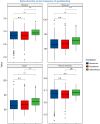Association of oral bacteria with oral hygiene habits and self-reported gingival bleeding
- PMID: 35569028
- PMCID: PMC9542802
- DOI: 10.1111/jcpe.13644
Association of oral bacteria with oral hygiene habits and self-reported gingival bleeding
Abstract
Aim: To describe associations of gingival bacterial composition and diversity with self-reported gingival bleeding and oral hygiene habits in a Norwegian regional-based population.
Materials and methods: We examined the microbiome composition of the gingival fluid (16S amplicon sequencing) in 484 adult participants (47% females; median age 28 years) in the Respiratory Health in Northern Europe, Spain and Australia (RHINESSA) study in Bergen, Norway. We explored bacterial diversity and abundance differences by the community periodontal index score, self-reported frequency of gingival bleeding, and oral hygiene habits.
Results: Gingival bacterial diversity increased with increasing frequency of self-reported gingival bleeding, with higher Shannon diversity index for "always" β = 0.51 and "often" β = 0.75 (p < .001) compared to "never" gingival bleeding. Frequent gingival bleeding was associated with higher abundance of several bacteria such as Porphyromonas endodontalis, Treponema denticola, and Fretibacterium spp., but lower abundance of bacteria within the gram-positive phyla Firmicutes and Actinobacteria. Flossing and rinsing with mouthwash twice daily were associated with higher total abundance of bacteria in the Proteobacteria phylum but with lower bacterial diversity compared to those who never flossed or never used mouthwash.
Conclusions: A high frequency of self-reported gingival bleeding was associated with higher bacterial diversity than found in participants reporting no gingival bleeding and with higher total abundance of known periodontal pathogens such as Porphyromonas spp., Treponema spp., and Bacteroides spp.
Keywords: bacteria; gingival bleeding; microbiome; oral hygiene; periodontal health.
© 2022 The Authors. Journal of Clinical Periodontology published by John Wiley & Sons Ltd.
Conflict of interest statement
The authors declare that there is no conflict of interest for this article.
Figures



References
-
- Ainamo, J. , Barmes, D. , Beagrie, G. , Cutress, T. , Martin, J. , & Sardo‐Infirri, J. (1982). Development of the World Health Organization (WHO) community periodontal index of treatment needs (CPITN). International Dental Journal, 32(3), 281–291. - PubMed
-
- Anderson, M. J. (2006). Distance‐based tests for homogeneity of multivariate dispersions. Biometrics, 62(1), 245–253. - PubMed
-
- Anderson, M. J. , & Walsh, D. C. I. (2013). Permanova, anosim, and the mantel test in the face of heterogeneous dispersions: What null hypothesis are you testing? Ecological Monographs, 83(4), 557–574.
-
- Astrom, A. N. , & Rise, J. (2001). Socio‐economic differences in patterns of health and oral health behaviour in 25 year old norwegians. Clinical Oral Investigations, 5(2), 122–128. - PubMed
Publication types
MeSH terms
Substances
Grants and funding
LinkOut - more resources
Full Text Sources
Medical
Miscellaneous

